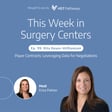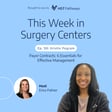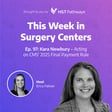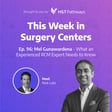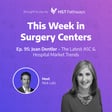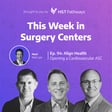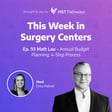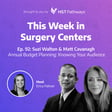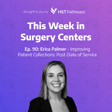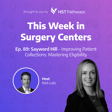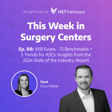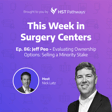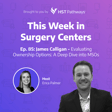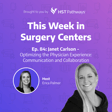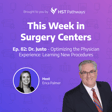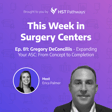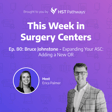Podcast Introduction and Format Overview
00:00:01
Speaker
Welcome to This Week in Surgery Centers. If you're in the ASC industry, then you're in the right place. Every week, we'll start the episode off by sharing an interesting conversation we had with our featured guests, and then we'll close the episode by recapping the latest news impacting surgery centers. We're excited to share with you what we have, so let's get started and see what the industry's been up to.
Cardiology Series Introduction: Cardio Cases in ASCs
00:00:27
Speaker
Hi, everyone. Here's what you can expect on today's episode. Today kicks off our three-week series that is all about capitalizing on the cardiology boom. Kristen Richards is the VP of cardiovascular operations at Atlas Healthcare Partners, and she will be our first guest of the series. And we had a great discussion about what ASCs need to consider if they're thinking about adding cardio cases into their existing mix. Preparing your infrastructure and staff definitely has some gotchas you do not want to overlook. And then Kristin also shares some really interesting numbers about the potential net revenue per case for some of these CV procedures. And after my conversation with Kristin, we'll switch to our data and insight segment. Today, I'll break down the average number of claims that are accurately paid, underpaid, or overpaid.
00:01:22
Speaker
And after sharing those stats of what 450 ASCs are experiencing, I'll get into how you can analyze your own numbers and steps you can take if you're consistently getting underpaid incorrectly. Hope everyone enjoys the episode and here's what's going on this week in Surgery Centers.
Cardiovascular Operations and Market Trends
00:01:45
Speaker
Kristin, welcome to the podcast. Thank you. Thanks for having me. Yeah. Can you share a little bit more about yourself with our listeners, please? Sure. So my name is Kristen Richards and I am the vice president of cardiovascular operations for Atlas healthcare partners. And if you're wondering what Atlas is or who they are in ASC management company with an operating model of focused really on joint ventures with health systems and physician partners to build an ASC strategy among all specialties. Very cool. And you are the perfect person to come on today to talk to us about what's going on with CV right now in the surgery center space. So at a high level, can you just explain briefly why cardiovascular procedures are becoming so common right now on top of mind in the industry?
00:02:39
Speaker
Sure. I would start off by saying that cardiovascular AICs are the new kid on the block, ah really the new kid on the block. And that is greatly driven by, I would say in 2019, we had a watershed moment in the cardiology space. And that's when CMS approved PCIs, percutaneous coronary interventions in the ambulatory surgery centers for 2020. So they added it to their covered procedure list for 2020. I'm not going to go into all what happened in 2020. We are all aware what happened then, right? So I would say that the CVASC space or setting didn't take off like many thought in the first year or so. And I would say we're now starting to get traction and see some momentum in that space today. Year over year, there's been there's growth and we're seeing
00:03:32
Speaker
There's about 85 to 100 CVASCs today in the US with about 50 under development. So there's growth happening in the CVASC setting. Love it. So let's say an existing surgery center is interested in adding CV cases into the
Steps to Add Cardiovascular Cases to ASCs
00:03:49
Speaker
mix. What is the first step they take? Where do they begin? Yeah, I think that's a pretty common question that we're seeing these days on what what do I do if I have an existing ASC? And I'll start basic ah around the fact that you should absolutely assess your market like you would normally for your multi-specialty ASC. So you're looking at your market. And then in order for you to do that, obviously you need to have a physician, right? And I would say most often when they're adding CV,
00:04:18
Speaker
to their existing ASC, it's generally an electrophysiologist that's doing cardiac device implants or loop recorders. So I think that's a good place to start. But in doing so, if that's the decision you're going to make, you need to understand are there any different licensure requirements you may have to re putt an application in for your license to update it, you may need to look at further regulatory requirements. So I would just address all those things that you did when you started your initial ASC, and now think about it from a CV standpoint on what might be required for me to do that from a legal standpoint. And then I would say it's once you've identified the types of procedures, you're you have a good understanding if it's the right mix.
00:05:08
Speaker
and And what I mean by that is electrophysiologists or their procedures, those device implants and loop recorders, on average, the net revenue per case is about $7,500. So you want to make sure that you have like cases, right? So net revenue per case. And I say this because this will be important to your physician investors. if there's inequities. Most of the physicians, their net revenue per case is only around $1,500, and then this doctor comes in and this doctor is $7,500. There's inequities there that will have to be discussed, understood, and agreed upon by but by all parties. So I would absolutely make sure that you're planning for that, you have a good understanding of that, and that everybody is in agreement. That's the right thing to do for the center.
Financial Insights: Revenue and Costs of Procedures
00:06:01
Speaker
7,500 per case is crazy high, right? We just did our state of the industry report late last year and I'm trying to go back. I think the i think Ortho might've been the highest from our data and it was only in the 3000s, might be butchering that. but No, that sounds about right. ah But if you think about Ortho as they're expanding into total joints now, the reimbursement or their net revenue per case is going to be a ah lot higher. So to your point, Ortho might be the right mix. if If you have an ASC, an existing ASC, and it's predominantly ortho, it might be the right mix to bring in electrophysiologists to start doing device implants. And it would complement the services that you're providing to your community.
00:06:47
Speaker
Gotcha. and let I would just want to go back to the first piece you met mentioned about finding the physician. Do you find that it's typically an existing physician that already has equity and works at that surgery center and they're able to expand and bring on more? Or are they usually looking for physicians that maybe they work with at the hospital that they could bring in brand new to the center? My guess would be that an existing ASC that doesn't already have cardiovascular services that they don't have somebody that can provide those services there, right? So they're already in a different specialty orho orthopedic surgeons or what have you. So they would definitely need to identify a physician that isn't, they'll have to understand the regulatory requirements for that physician, right? Are they employed? Are they independent? There's all kinds of nuances around that as well, right? But identifying who's the right physician,
00:07:41
Speaker
that is interested in joining an ASC to be able to provide additional services and complement, again, the services that they're providing to the community. So there's some work ahead of time, but again, I would guess that most of these centers already have an idea and are already having discussions with electrophysiologist around, hey, are you interested in joining our center? We think you would be a great complement in providing services. So i I would say that's probably already happening, but if it's not, you're absolutely going to have to take that step to do that. Sure. Makes sense. All right. So let's pretend we get the physician on board. We've done the pro forma. Market looks good. How can surgery centers prepare their infrastructure? Yeah.
00:08:30
Speaker
there are quite a few things they need to consider, right? Again, so if we're just talking device implants, their infrastructure they need to understand, do they have, most often for device implants, a mobile CRM is adequate, but if you were going to further explore cardiovascular procedures and consider doing cardiac casts, now we're talking fixed imaging systems that are over a million plus dollars to ah to build out in your existing infrastructure. So again, if you already have an existing mobile CRM and you're considering cardiac device implants, it's a great strategy, right? That can be done. You would also need to consider cardiac monitoring for these patients, right? Any cardiac patients coming into your center should be monitored from pre-op all the way to discharge so that you are
00:09:25
Speaker
monitoring them and safely providing care to them during their procedure all the way from start to finish. I think that's really important. Any other types of technology, ensuring most ASCs would have a code cart, you tend to have more additional code carts in a CV-ASC center, but just making sure that you have appropriate equipment and technology around that to provide that type of care. And I would also consider Just thinking through your procurement strategy, your supply chain strategy, because device implants are not cheap. They're very expensive and you don't have to bring those in. on Most of them won't consign. I'd be surprised if you could find somebody that would consign. So your best strategy is not to buy a bunch and put them on the shelf, but that you would have a have an agreement with your vendor or vendors that they would do trunk stock. So you would
00:10:25
Speaker
purchase Do a purchase order the day of the procedure or post procedure to pay for the device, if that makes sense. Yeah, it definitely does. A million dollars just for that one piece of it. Let's switch gears to the financial implications. Obviously, everyone wants ah ROI for adding CV cases, but what so talk me through some of the financial implications, including that potential ah ROI of adding these cases. Sure. So for a straight up CVASC center, right there is tremendous technology that you need to have to build out your center. So they are not for the faint of heart. It's expensive to build out a CVASC center with imaging equipment. ah Most often these centers could potentially do a fixed system, which is, like I mentioned, a little over a million dollars once you look at the software and all the other things that you need for that.
00:11:18
Speaker
as well as adding a mobile CRM as well. It's a good complement to have both of those and then you have a wide variety of procedures that you're able to do with both of those different types of systems. So it's not cheap that absolutely to outfit one of these, but absolutely from the cardiovascular space, these types of procedures, and I would especially talk about the electrophysiology procedures, so device implants, loop recorders, those are generally the highest net revenue per case, and they're a great complement to cardiovascular centers. It's why you see a mixed of
00:11:53
Speaker
electrophysiologists, interventional cardiologists, as well as vascular surgeons in these centers, really to be successful. But you could see that certainly applies to adding CV to your existing ASC, especially if you're talking about device implants.
00:12:11
Speaker
yep Yeah, that makes sense. I could see how there's a lot of potential there, especially if we're looking at that $7,500 net revenue per case.
Staffing and Recruitment for Cardiovascular ASCs
00:12:19
Speaker
I want to talk about staff because when I sat in on your presentation and asked, and this was one of the most eye-opening or interesting pieces that I think you mentioned was preparing your staff and maybe the need to bring in staff outside of just the physician that you don't currently have. So talk me through a little bit of that. How can you prepare your current staff? What new skills do you need to bring in?
00:12:43
Speaker
for an ASC, a CB, ASC, obviously the most prudent thing to do is to bring in highly skilled and trained. CV cath lab folks and that's what we tend to do. Most of our centers are filled with highly trained, highly skilled folks that come from the cath lab so cath lab RNs, cath lab rad techs, scrub techs to fill the need and fill the spaces that we are the positions that we need to fill to actually provide services at the center.
00:13:15
Speaker
With that said, staffing is challenging these days and it's not unique to the ASC space, right? It's all across the country. There is clearly, there are healthcare care staff shortages happening all across the country. So that's the challenge that ASCs are going to continue to have on one hand. You are an ASC that operates Monday through Friday, no weekends, no holidays, no call. Extremely attractive to cath lab folks or any procedural folks that are used to working call and holidays, weekends. You could provide an environment where they don't have to do any of that. It's just Monday through Friday. They're usually eight to 10 hour shifts. They go home when they go home on time. So it's a very attractive model, but you also have to recognize the fact that
00:14:03
Speaker
yeah is those staff, our specialty staff, and they're hard to come by. And sometimes you're stealing them from your hospital partners. And for us, we're constantly reminded of that from our health system JVs that we're not taking all of their staff, but you still need to have a complement of experienced folks in a CV, ASC, because that's what builds the confidence of your physicians And again, incentivizes them even further to come to your center because they feel confident. They know the staff is proficient, that their patients are going to be cared for at the highest quality. Yep, definitely. So if you're looking at your crystal ball right now, what does the cardiovascular and outpatient landscape look like, let's say 10 years from now?
00:14:53
Speaker
It's exciting. I think it's going to continue to grow, right? So Medicare is going to continue to add procedures to the covered procedure list. We're seeing that right now. So I believe, we believe based on a recent HRS, the Heart Rhythm Society conference that just happened, that HRS and the ACC combined and and wrote a letter to CMS to say, Hey, we support ablation is being done in the ASC setting. So I look forward to that happening where we could see afib ablation happening as early as 2025. That's another movement of adding another service line.
00:15:30
Speaker
that can be safely done in an ASC. But I would also say that not to scare people, but the the future's bright when looking at structural heart procedures can be done in here. You could look at renal denervation is back and it's being done in a hospital setting. Hasn't been approved in the ASC setting yet, but it's a perfect location for those procedures to be done. right we' focused on providing a lower cost setting for our patients that that embraces value based health care that provides greater access they have great patient experience physician experience and being able to just add additional procedures and more procedures in the future is absolutely going to happen as we continue to capture data and most of these patients are being done and outpatient so then
00:16:15
Speaker
The data showing that they could safely be done in an out in an outpatient or a shift to an outpatient center as opposed to be being done in an acute care facility and open up that space in the hospitals for those patients who really need acute care services. I think it's very exciting. I think you'll also see Things maybe cardiac rehab could be done in these types of space or adjacent to it, I would say. You might see that it's almost a one-stop shop. A patient could come in and have advanced imaging right next door, could have cardiac rehab, could have other additional tests like CTFFR, MRI, and then they could move over into the ASC and have a procedure done. So I think we'll start to see more of that happen in the future. And that's really exciting for what's coming.
00:17:03
Speaker
for the CVAFC space. Yeah, it is really exciting.
State Regulations and ASC Advocacy
00:17:08
Speaker
And I think one thing we should have maybe mentioned earlier was how current regulations vary state by state. So if someone listening is in a state where most of these or all these procedures are not yet approved, I'm sure they're all working with their state associations and things like that. But is there anything that someone could do right now if they're in a state to try to move things along? Well, that's a great call out and you're right. we We do need to mention that because every state varies. There's different rules and regulatory requirements that they have to adhere to. There are still quite a few certificate of need states, but we're starting to see those barriers being brought down by legislature and it's because of the cardiology community at large really taking an interest and working with their state legislators on removing those barriers.
00:18:04
Speaker
And embracing, if we really say we want to embrace value-based health care and provide a lower cost setting of care for patients, we have to remove some of these barriers and allow these ASCs to be developed and built and to provide cases to the community, right? Or to provide procedures to the community at large. And I think if you're actively involved in that, that speaks volumes. And they want to hear from the Physicians that are actually doing those procedures on the why it makes sense and support quality metrics that need to be done but those are happening all across the country i even year over year we're seeing more of those certificate of need or regulatory restrictions. Being eliminated based on again the.
00:18:51
Speaker
advocacy that's happening around in each state around that. So continue to do that, participate in it, but you absolutely need to understand your rules and regulations in your state as you're proceeding and are considering an ASC strategy in the future or today or in the future. Yep, said.
Optimizing ASC Performance and Addressing Payment Discrepancies
00:19:11
Speaker
All right, Kristin, we do this every week with our guests. What is one thing our listeners can do this week to improve their surgery centers?
00:19:22
Speaker
I think you heard me talk about this a little bit and in my talk at ASCA but something that's really near and dear to my heart is making sure that we are measuring to manage performance and what I mean by that is that you're measuring quality performance of your center and you're doing it in a way that you can manage performance and that you're optimizing patient care. So if you're not capturing any quality metrics today for CV patient selection or any complications,
00:19:55
Speaker
put something in place so that you start looking at that and paying attention to it. So again, that you're optimizing care in this setting and that you have a way to prove it in the future, right? So you could now have a negotiation with payers in the future because you're capturing data. That's what I would say. I would i would say it's about capturing data that is actionable. that helps you drive improved performance in your clinical, financial, and operational performance of your ASE. Probably a lot, but that's just how I feel strongly about it. That is excellent advice. I appreciate you coming on and sharing all of your insights with us, and thanks again for coming on. Absolutely. Thanks for having me. I'll talk to you again soon sometime.
00:20:47
Speaker
Welcome to Data and Insights, where we turn data into dialogue and numbers into narratives. HSC Pathways released a State of the Industry report highlighting best practices, key process steps, and KPIs for every step of the patient journey and for nearly every recurring administrative duty. Most importantly, we used our own unique data set from our clients to extract data points so that anyone in the industry could compare themselves to their peers. To disclaimers, we only pulled data from clients who gave us permission and we omitted any extreme outliers. All right. So today we'll be looking at a breakdown of payment amounts versus contracted fees. We looked at roughly 450,000 claims submissions from over 450 ASCs across the country. And we found that of those 450,000 claims, 7% were paid accurately.
00:21:45
Speaker
8% were overpaid and a whopping 85% were underpaid. And just so we're all on the same page, the contract fee is that agreed upon rate between the surgery center and the payer for a specific procedure. That's set through negotiations and it's specified in a contract, thus making it the contract fee. And then the payment amount is the actual amount paid by the payer to the surgery center after a claim gets submitted. And it can be influenced by a number of factors, which we'll get into in a few minutes. We're looking at co-pays, deductibles, adjustments, discounts. There are a lot of things that could impact that payment amount.
00:22:25
Speaker
And as you can imagine, monitoring that data point is extremely important to make sure that your surgery center is collecting every penny that you're contractually owed. Okay, so let's say you're just getting started and you really want to dig in to see your payment amount versus contracted fees. So first we're going to do the typical initial step, which is to conduct a thorough audit of the claims and payments so that you can try to identify patterns and any specific instances of underpayments. You can do this by simply comparing the actual payment received against the contracted fee.
00:23:03
Speaker
And you could pick a timeframe, let's say, maybe you want to look at the last six months, the last nine months, or maybe you want to do it by number of claims. So maybe you want to look at the last 1000, 2000, as long as you're consistent in that data set, you'll be fine.
00:23:20
Speaker
So after you've done, you've analyzed a little bit, pulled your data set. ah The second thing you're going to want to do is to really review your contract terms with each payer to ensure you have a clear understanding of the agreed upon rates and payment terms. Knowing your contracts inside and out is going to make this analysis, but also your life in general, a lot easier. You'll also want to check if the fee schedules are up to date or if any changes in the contract terms might have been missed. So if you're just doing this for the first time, step one and step two might take you some time. But once you get into this routine, those will go quickly.
00:24:00
Speaker
So now that you've done that, it is time to analyze, right? You have a breakdown of the claims that were underpaid and you have a clear understanding of your contracts. So now we can try to make sense of why the claims were underpaid. Was it a coding error, documentation issue, policy change, an outdated contract, a late submission, a bundling issue, lack of pre-auth, secondary insurance issue, a clearinghouse error. There are a lot of things that could cause you to get under or could could take place so that you get underpaid. Also, either way, I've been hearing more and more that payers are knowingly underpaying with the assumption a surgery center won't catch it or won't have the bandwidth to even follow up. So don't feel crazy if you can't find a reason. You may have done everything right and still been underpaid. So step four, ah you've completed your analysis. Now what?
00:24:56
Speaker
Based on your findings, your next steps will of course vary, but here are some different directions you might need to go in. If you find it to be an in-house problem, you might need to just invest in more training for your billing and coding staff. You could look to outsource to a revenue cycle partner or look into revenue cycle management software that could help scrub claims before submissions or flag under payments for you. Or perhaps you need to contact your payer reps. If you do, make sure you are over prepared for that meeting and can provide detailed evidence of the underpayments and requests of review and correction. You may need to resubmit claims or in extreme cases, you can file a formal appeal. Or if it's an ongoing issue, you might want to try to schedule a recurring standing meeting with your payer reps. That could help, or maybe it's time to start to prepare to renegotiate your contracts.
00:25:51
Speaker
And then on an ongoing basis, you should be looking at your payments on a daily or weekly basis, and you're really looking for three things. Are the payment amounts generally matching the contract fees? If payment amounts are consistently lower than contract fees, why? And then are there any visible trends over time? So by taking all of these steps, you can definitely address underpayments effectively and make sure you receive appropriate compensation for your services.
Podcast Conclusion and Engagement Encouragement
00:26:20
Speaker
If you're interested in more data points and use cases, subscribe to the podcast, of course, so that you don't miss any upcoming data and insight segments, or you can always head to our website, to HST's website, to check out the full state of the industry report to get your hands on even more data.
00:26:37
Speaker
And that officially wraps up this week's podcast. Thank you as always for spending a few minutes of your week with us. Make sure to subscribe or leave a review on whichever platform you're listening from. I hope you have a great day and we will see you again next week.

